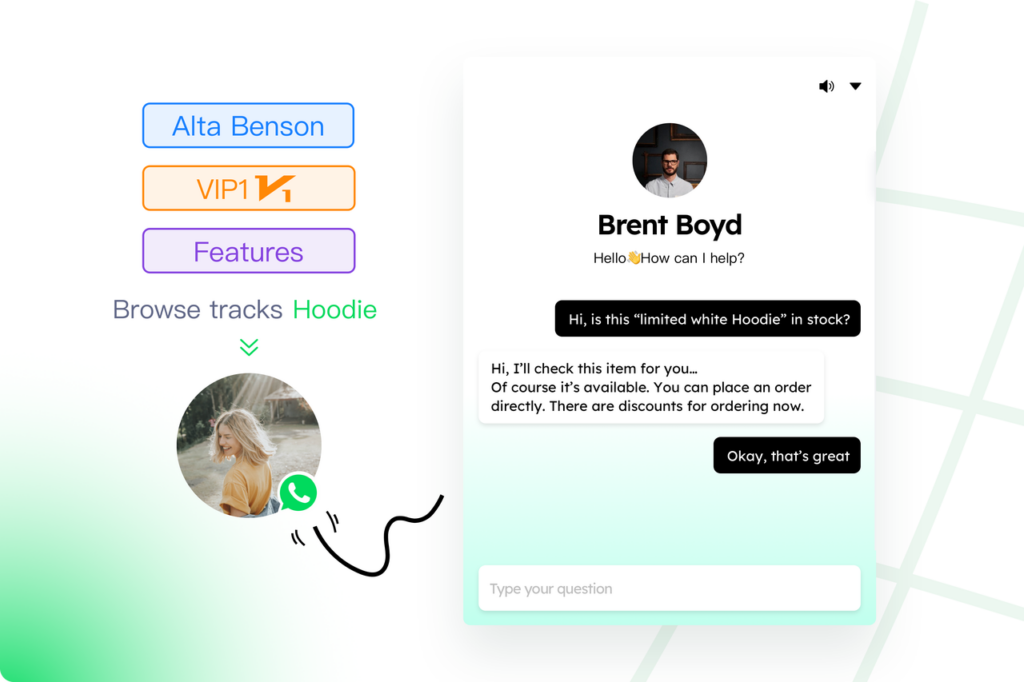Author of this article:Miya, Search engine optimization expert
With the acceleration of globalization, more and more companies are looking at the cross-border e-commerce market. Data show that as of the end of August 2023, ChinaThe total number of cross-border e-commerce companies has reached more than 61,000, The total amount of commodity transactions generated by international online trade accounts forA large part of China's total international trade。 This trend has also brought new development opportunities and challenges to customer service.
Mixdesk
AI Agent

- New opportunities for global cross-border e-commerce services
- The importance of cross-border e-commerce customer service
- Challenges faced by cross-border e-commerce customer service
- The core qualities and skills of cross-border e-commerce customer service
- Cross-border e-commerce customer service reply techniques and practices
- Performance appraisal indicators for cross-border e-commerce customer service
- Comparison and case analysis of the quality of cross-border e-commerce customer service
- Cross-border AI customer service: the Advantages of Automated customer service
- Which cross-border customer service tool is better?
- Summary: Build an efficient cross-border e-commerce customer service system
New opportunities for global cross-border e-commerce services
Facing the diversified needs of consumers in different countries, how to provideConsistent and effective customer serviceIt has become an issue that cross-border e-commerce companies must pay attention to. Whether it is pre-sales consultation or after-sales support, cross-border e-commerce customer service greatly affects consumers' purchasing decisions. According to Salesforce The investigation,80% of consumersIt is believed that the brand's customer service experience is as important as product quality. Therefore, cross-border e-commerce companies not only need to pay attention to product quality, but also to impress consumers from the service level.
In such a market environment, more and more companies are beginning to take advantage of AI Technology optimizes the customer service process to meet the diverse needs of cross-regional customers. This kind of intelligent transformation can not only improve the efficiency of customer service, but also help companies reach global customers at a lower cost, laying the foundation for future business growth.
The importance of cross-border e-commerce customer service
inCross-border e-commerceAmong them, customer service is not only a simple after-sales support, but also an important channel for brand value transmission. The core role of cross-border e-commerce customer service is mainly reflected in three aspects:

Improve customer satisfaction: inCross-border transactionsAmong them, consumers may be uneasy due to factors such as long logistics times and differences in product expectations, and the timely response and effective solution of customer service can alleviate this anxiety.
Drive sales conversion: Customer service not only plays a role in the after-sales stage, but also directly affects the purchase decision in the pre-sales consultation. For example, providing detailed product information and answering doubts can help promote conversion. At the same time, the response speed and professionalism of customer service will directly affect consumers' purchasing confidence.
Maintain brand reputation: The quality of service of cross-border e-commerce customer service directly affects the brand's image in the international market. For cross-border e-commerce, good customer service can win a positive reputation for the brand, especially inSocial mediaAnd on the evaluation website. Positive word of mouth can not only drive direct sales growth, but also effectively enhance the brand's global influence.
Challenges faced by cross-border e-commerce customer service
Language and cultural differences: Cross-border e-commerce services involve consumers in different countries, and different languages, expression habits, and cultural customs may lead to misunderstandings. For example, some words may have different meanings in different countries. Customer service needs to be very careful in the communication process to avoid misunderstandings caused by cultural differences.
Time zone difference: Cross-border e-commerce customers come from different time zones, which means that companies must provide 24/7 customer servicesupport. Many customers want to get a quick response when they consult or complain, which puts forward high requirements for the work arrangement and response speed of the customer service team.
The complexity of multi-platform and multi-channel management: Cross-border e-commerce customers usually consult through multiple channels, such as e-commerce platforms, social media, e-mail, etc. Messages from these different channels need to be centrally managed and responded to in a timely manner. For companies, how aboutEfficiently integrate these channels, Ensuring that messages are not missed and responding quickly is a major challenge.
About“How to efficiently build an overseas social media platform matrix?”More content of >>
Improvement of customer expectations: With the globalization of e-commerce, consumers' expectations for cross-border customer service are also rising. Whether it is timeliness, professionalism, or communication quality, consumers expect the same or even higher service standards as local services. Therefore, cross-border e-commerce customer service must not only have basic service capabilities, but also continuously optimize the details to meet or even exceed customer expectations.
The core qualities and skills of cross-border e-commerce customer service
1. Language and cultural sensitivity
Cross-border e-commerce customer serviceIt is necessary to deal with customers from different cultural backgrounds around the world, so it is essential to master different languages and understand multiculturalism.:
Improvement of language skills: Mastering the language of the customer's country can not only improve communication efficiency, but also narrow the psychological distance with the customer. If customer service can answer questions in the customer's native language, customers tend to feel more trusting and cordial. In addition, understanding the professional terms and usage habits in the industry can also avoid misunderstandings caused by improper expression.
Cultivation of cultural sensitivity:Consumers in each country have different shopping habits and communication methods. For example, American consumers generally like direct communication, while Asian consumers pay more attention to polite and meticulous communication styles. Cross-border customer service teams need to understand and respect the cultural differences of customers in order to show respect for customer culture in the service process, so as to avoid unnecessary misunderstandings and friction.
2. Communication skills and problem solving skills
Efficient communication and rapid problem-solving are the basic capabilities of cross-border e-commerce customer service, as well as the core competitiveness of cross-border e-commerce customer service:
Rapid response ability: In the field of e-commerce, time is a business opportunity, especially when dealing with customer complaints. Customer service needs to understand the customer's demands in the shortest possible time and respond quickly. For example, in the face of customer demand for product returns and exchanges, customer service needs to be able to quickly judge and provide customers with appropriate solutions.
Friendly and professional communication skills: Customer service needs to be patient, friendly and convey a professional image in the communication process to establish a good brand image. Customer service of cross-border e-commerce companies often face a stressful work environment, so it is particularly important to have calm and stable emotional management skills.
Problem-solving ability: The order processing of cross-border e-commerce usually involves multiple links, from logistics, customs declaration to after-sales, all links may have problems. Therefore, customer service needs to have the ability to independently analyze the problem, be able to find the root cause of the problem in the first time, and propose practical solutions to customers. This kind of problem-solving ability can not only improve customer satisfaction, but also significantly reduce customer churn rate.

Cross-border e-commerce customer service reply techniques and practices
1. Standard speech design in different scenarios
In different customer service scenarios of cross-border e-commerce, standardized response techniques can help improve customer service efficiency and ensure that customers receive consistent high-quality service. The following are the standard dialogue designs in the three main scenarios:
(1) Pre-sales consultation techniques In the pre-sales stage, customers usually have doubts about the quality, size, material or delivery method of the product. Discourse design should focus on providing detailed and accurate information to dispel customer concerns and promote transformation.
For example:
️️When customers ask about product quality, they can reply: “Hello, thank you for your attention to our products!" Our products strictly follow international quality standards to ensure excellent quality. If you have any special needs or concerns, feel free to let us know! ”
️️When customers hesitate to purchase, the customer service can appropriately introduce the offer or recommend it: “In order to thank you for your attention, we currently have a limited time offer, you can enjoy a special discount! ”
(2) After-sales problem tactics After-sales problems usually include returns and exchanges, product damage or after-sales protection. The design of discourse should be based on empathy, first express the understanding of the customer's problem, and then clarify the solution.
For example:
️️When customers request a return, they can reply: “Sorry for the inconvenience, we will process the return request for you as soon as possible. Please send us the product photo and order number so that we can better help you solve the problem. ”
️️For after-sales warranty consultation: "All our products have after-sales guarantee, please feel free to use it. If you have any questions, please feel free to contact our customer service team. ”
(3)Logistics delays and commodity problem handling techniques In the process of cross-border logistics, delays and product damage problems occur from time to time. Customer service should express empathy in their words and appease customer emotions in a timely manner.
For example:
️️When the logistics is delayed: “We are very sorry for the inconvenience caused by the logistics delay. At present, we are actively communicating with the logistics company to ensure that your package is delivered as soon as possible. If there is any latest progress, we will notify you as soon as possible! ”
️️When the product is damaged: “I am very sorry for the damage to the product you received. Please provide photos and order information, and we will arrange an exchange or refund for you to ensure that your shopping experience is guaranteed. ”
2. Communication skills to improve customer satisfaction
In cross-border e-commerce customer service,Improve customer satisfactionNot only rely on the content of words, but also use communication skills to resolve the negative emotions of customers and promote repurchases.:
Empathy and active care:When communicating with customers, customer service should express empathy so that customers can feel respect and understanding. For example, when a customer is dissatisfied with a logistics delay, the customer service can first express their understanding: “We understand your feelings very well, and we are sorry for the inconvenience caused. ”
Use positive language:Positive language can effectively ease customer dissatisfaction. For example, “Although there is a slight delay in logistics at the moment, we will do our best to ensure that your order is delivered as soon as possible! ”This expression allows customers to feel the sincere service attitude of customer service.
Good at summarizing and providing solutions:When responding, the customer service should summarize the customer's problem as clearly and succinctly as possible, and immediately provide corresponding solutions so that the customer can see the progress of the problem. For example: “The return problem you mentioned has been recorded, and we will deal with it for you as soon as possible. You can check the email later. ”
Friendly reminder to promote repurchase:At the end of the communication, customer service can appropriately recommend other products or provide discounts to promote repurchases. For example, “Thank you for your support! To thank you for your understanding, we will send you an exclusive coupon and look forward to your next visit! ”
Performance appraisal indicators for cross-border e-commerce customer service
1. Response time and timeliness of resolution
In cross-border e-commerce, the response time and resolution timeliness of customer service are key indicators to measure customer service performance. Timely response and efficient solutions can not only improve customer satisfaction, but also significantly reduce the chargeback rate and customer churn rate. The following are specific practices on how to optimize response time and resolution timeliness:
Set response time standards: According to platform requirements and industry standards, set goals such as “respond to real-time chat within 30 seconds” or “Reply to email inquiries within 24 hours”. Intelligent reminders of the customer service system can be used to ensure that the customer service team responds to customers within a set time.
Establish a quick resolution process: Establish a rapid processing process through the classification and standardization of common problems. For example, establish corresponding quick handling methods for logistics issues, returns and exchanges, and set priorities.
Data monitoring and feedback: Monitor the response time and resolution timeliness of customer service through data, regularly analyze and optimize the process. Team allocation and scheduling can be adjusted based on data feedback to ensure efficient service.

2. Conversion rate, repurchase rate and customer satisfaction
These indicators directly reflect the effect of customer service on sales promotion and customer satisfaction with service. The key to optimizing these indicators is to continuously improve the quality of service through data analysis:
Conversion rate: Analyze the conversion rate of customer service in pre-sales consultation, and use data tracking to see which tactics and communication methods are easier to facilitate orders. Regularly review high-conversion techniques and promote them to all staff.
Repurchase rate: For purchased customers, increase the repurchase rate through after-sales follow-up, customer care and other means. Regularly track repurchase data to determine which service links can best promote customers' secondary purchases.
Customer satisfaction (CSAT): Collect customer feedback through questionnaires, online ratings, etc. to understand customer satisfaction with customer service. Analyze the problems mentioned in the feedback, optimize the customer service process and formulate a training plan.
3. Training and assessment mechanism of cross-border customer service team
In order to improve the overall performance of customer service, systematic training and a reasonable evaluation mechanism are indispensable:
Regular training plan: According to the specific needs of the customer service team, design training courses related to cross-border e-commerce, such as language skills, cross-cultural communication skills, and common problem handling. The training content should include basic knowledge, new skills and advanced skills in solving complex problems to ensure the improvement of the overall quality of the team.
Hierarchical assessment mechanism: The performance appraisal of customer service should cover response time, timeliness of resolution, customer satisfaction and sales conversion. Through hierarchical assessment, we ensure that we not only pay attention to service speed, but also pay attention to service quality.
Incentive and feedback mechanism: Provide corresponding reward mechanisms for outstanding customer service personnel, such as monthly bonuses, performance rewards, etc., to motivate the team. At the same time, through monthly or quarterly performance feedback, help employees understand their shortcomings and give suggestions for improvement.
Comparison and case analysis of the quality of cross-border e-commerce customer service
1. Characteristics of excellent cross-border customer service
The customer service performance of cross-border e-commerce can directly affect the brand's international image and market reputation. Excellent cross-border customer service usually has the following characteristics:
Timely response Efficient response speed is particularly important in cross-border e-commerce, especially in the face of customer needs in different countries and time zones. Excellent cross-border customer service usually responds to customers' real-time inquiries within a few minutes to ensure that customers feel followed and respected while waiting. This kind of rapid response not only improves customer satisfaction, but also effectively avoids customer churn due to delays.
Barrier-free communication Cross-border e-commerce customer service must have good language skills and be able to accurately understand customer needs to avoid misunderstandings caused by language or cultural differences. Excellent cross-border customer service can not only use the customer's native language or main language, but also adjust the communication method according to cultural differences, so that customers can feel a cordial and professional service experience.
Continuous follow-up Cross-border e-commerce involves long logistics time and complex after-sales service. Excellent customer service will continue to follow up with customers after the order is completed, especially to care for and give feedback to customers who encounter problems. For example, after dealing with the issue of returns, you can also regularly follow up on customer satisfaction, so as to establish a good reputation for the brand.
High customer problem solving rate Excellent customer service will regard the solution rate of customer problems as the core goal, not only to answer customer inquiries, but also to pay more attention to the actual solution of the problem. The cross-border customer service team should have clear processes and authority, and when the problem exceeds the processing authority, it can be upgraded to a higher level of customer service or related departments in a timely manner to ensure that customer needs are resolved quickly and effectively.
2. Typical bad review cases and problem analysis
Through actual negative case analysis, it can help cross-border e-commerce companies identify common problems and avoid similar errors.:
(1)Case 1: Logistics delay and failure to communicate in time
Case description: A customer encountered a logistics delay after purchasing a cross-border e-commerce product, but the customer service did not inform the latest progress in time, causing the customer to be dissatisfied and leave a bad review on social media.
Problem analysis: In cross-border e-commerce, logistics delays are a common problem. Because the customer is not clear about the status of the order, there may be anxiety, and the customer service fails to take the initiative to follow up at this time, and the lack of information communication exacerbates the customer's dissatisfaction.
solution: When encountering uncontrollable factors such as logistics delays, customer service should take the initiative to inform customers at the first time and update the logistics status regularly. The automated notification system can ensure that customers receive timely notifications when the logistics status changes, thereby alleviating customer anxiety.
(2)Case 2: Improper communication method leads to customer misunderstanding
Case description: A European customer had questions about the specifications of the product. The customer service directly sent the English form of the product specifications without explaining it in detail, which caused the customer to misunderstand the product content and eventually become dissatisfied.
Problem analysis: When customers ask questions, they often expect a clear explanation, not a simple document or link. Sending specification information directly does not take into account the customer's understanding needs, resulting in incomplete information transmission.
solution: When answering customer questions, customer service should briefly summarize the key contents in the document or form and provide further explanations to ensure that customers fully understand the product information. Especially in cross-cultural communication, cultural and language differences should be noted, and one-way cold replies should be avoided as much as possible.
(3)Case 3: The complicated return and exchange process leads to poor customer experience
Case description: A customer has a problem with the goods received and proposes a return or exchange request, but the customer service requires the customer to provide multiple certification materials and the process is complicated, resulting in a poor customer experience.
Problem analysis: The overly cumbersome return and exchange process makes customers feel inconvenient and may cause customers to feel “embarrassed”. This situation is very common in cross-border e-commerce, and it often has a negative impact on customer loyalty.
solution: Simplify the return and exchange process, set up a quick process for common problems, and reduce the supporting materials that customers need to provide. Continuously optimize the return and exchange rules through data analysis, so that customers can feel the convenience and humanization of corporate services.

Cross-border AI customer service: the Advantages of Automated customer service
1. Definition and development of cross-border AI customer service
Cross-border AI customer service refers to an intelligent customer service system built through AI technology, which can automatically answer and process customer inquiries from different regions and languages. It combinesNatural Language processing (NLP)、Machine learningAnd data analysis and other technologies can efficiently identify user needs and provide corresponding support. In the global e-commerce industry, AI customer service is developing from a simple automatic response function to an intelligent system that can understand and adapt to complex problems.
In cross-border e-commerce, the application of AI customer service has rapidly spread. For example, many e-commerce platforms and independent sites have introduced intelligent customer service robots to help companies automate most common customer issues, such as logistics inquiries, order status, returns and exchanges, etc. Gartner predicts that by 2025,全球80%的客户服务互动将通过AI来完成, Showing the important position of AI customer service in the e-commerce industry. When cross-border e-commerce companies adopt AI customer service, they usually also carry out localization optimization to enable them to more accurately respond to customer needs in different regions.
2. Advantages and applicable scenarios of cross-border AI customer service
Cross-border AI customer service has multiple advantages that cannot be achieved by traditional manual customer service, especially in the following aspects.:
Efficiency in responding to common problems: AI customer service can quickly answer users' frequently asked questions through preset speech skills and question classification, such as "When will the order arrive?" ", "How to apply for a return or exchange?" ”wait. This method not only improves the response speed, but also effectively diverts the pressure of manual customer service and concentrates manual resources on complex problem handling.
Increase response speed: Cross-border e-commerce involves customer inquiries in different time zones, and it is difficult for traditional customer service to achieve 24-hour uninterrupted service. AI customer service can realize a 24/7 online response and provide a reply immediately when a customer initiates a consultation, thereby significantly improving the customer experience. According toInvespAccording to the data, 65% of consumers believe that the response speed of the brand is very ideal within 3 minutes.
Save labor costs: Cross-border customer service usually requires more labor costs, and AI customer service can reduce the operating costs of enterprises to a certain extent. Even in the peak sales season when the order volume is high, AI customer service can maintain efficient response capabilities. In addition, the AI system can continuously optimize itself based on customer feedback and data, gradually reducing manual intervention, thereby reducing labor investment.
Multi-language support and intelligent recommendation: The AI customer service system can support multiple languages and performs well in handling customer needs in different regions. The advanced AI customer service system can also make personalized recommendations based on customers' past purchase records, browsing history and other information, thereby improving customer satisfaction and order conversion rate. This kind of personalized service is particularly important in cross-border e-commerce and helps to build customer loyalty.
Data collection and analysis: AI customer service can record and analyze data for each interaction, and gain insight into customer behavior trends, preferences, and common problems through data analysis. In this way, companies can better understand the customer needs of different markets, continuously optimize product and service processes, and improve the overall customer experience.
3. The integration strategy of manual customer service and AI customer service
Although AI customer service has many advantages, relying entirely on AI customer service can also affect the customer experience, especially when encountering complex or emotional problems. A reasonable strategy for the integration of manual and AI customer service can improve customer satisfaction while maintaining efficiency.
Intelligent diversion: initial screening of AI customer service and manual transfer of complex problems: In the customer service system, AI can be responsible for handling common problems and simple inquiries, such as order inquiries, product information, logistics tracking, etc. When the customer's problem exceeds the processing scope of the AI customer service, or the customer expresses a strong dissatisfaction or demand, the system will automatically transfer the consultation to the artificial customer service. This diversion mechanism can ensure that the customer service system is both efficient and humanized.
Manual customer service support and optimization of AI customer service: Manual customer service is not only the backup support for AI customer service, but also through continuous optimization of the response quality of AI customer service. By analyzing the solutions of manual customer service, the AI system can continue to learn and improve its automatic response capabilities. In addition, the feedback from manual customer service can help AI optimize its response strategies to new problems or emergencies, so that the entire system can continue to improve itself.
Seamless connection and customer experience assurance: In the process of seamless integration between AI customer service and manual customer service, it is particularly critical to ensure the customer experience. For example, when AI customer service transfers inquiries to humans, repeated questions and answers should be minimized. AI customer service can summarize the customer's background information and key points of the problem during the transfer, so that manual customer service can quickly take over and provide targeted responses, thereby improving customer satisfaction.
Which cross-border customer service tool is better?
1. The main functional requirements of cross-border customer service tools
While cross-border e-commerce customer service tools meet the needs of customers in different countries, cultures and languages, they need to have a number of functions to ensure that customer service serves global customers efficiently and professionally. The main functional requirements are as follows:
Multi-language support In order to meet the needs of global customers, customer service tools should support multi-language translation and automatic language recognition functions, which can enable customer service to easily communicate with customers in different languages. Multilingual support can also help the customer service team to serve customers in different countries more efficiently and reduce communication problems caused by language barriers.
24-hour response and automation service:跨境电商的客户常分布在不同的时区,客服工具需具备 24/7 The response function ensures that customer issues can be dealt with at any time. Through automated replies and intelligent customer service robots, tools can answer simple frequently asked questions while ensuring 24/7 online support.
Multi-channel aggregation:客户通常会通过不同平台与品牌互动,如电商平台的消息系统、社交媒体、电子邮件等。一个高效的跨境客服工具应具备多渠道聚合功能,能够Centralize messages from various channels in the same interface, To facilitate the customer service team to follow up on customer needs in a timely manner.
Intelligent customer management:客服工具应具备客户信息管理与分析功能,包括客户历史记录、购买偏好、问题类型等。通过数据分析,客服工具可以帮助企业精准了解客户需求,预测客户问题,并提供个性化服务。
Automatic allocation and ticket management:在跨境电商中,客户需求量大,客服团队规模也较为庞大。一个优秀的客服工具应能够Automatically assign customer needs, To ensure that the workload of each customer service staff is balanced. At the same time, the work order management function can classify complex problems for easy follow-up processing and tracking.
2. Comparative analysis of cross-border e-commerce customer service tools
There are a variety of well-known cross-border e-commerce customer service tools on the market, each of which has its own advantages and disadvantages in terms of automation, ease of use and cost. The following are several customer service tools recommended based on the market demand and cost performance of cross-border e-commerce:
Mixdesk:Mixdesk具备强大的多平台聚合和智能客服功能,特别适合跨境电商的复杂场景。Mixdesk 的 AI 驱动客服系统不仅可以支持 24 小时的自动回复,还能对客户消息进行多语言翻译。Mixdesk 的聚合功能极大方便了企业的全球化客户服务需求,帮助团队统一管理来自各渠道的客户信息,是高性价比的跨境客服工具选择。

Freshdesk:Freshdesk 在界面友好、功能全面方面表现优异,性价比较高,特别适合中小型企业。其自助服务功能能有效减轻人工客服负担,对于多语言支持有较好的适配。如果企业预算有限且团队规模中等,Freshdesk 是一个合适的选择。
Zendesk:Zendesk 适合大型跨境电商企业,其多层次客户支持功能可支持复杂业务场景。尽管价格偏高,但其强大的自定义能力、数据分析和客户管理功能,能够满足大型企业对深度客户服务的需求。
Tidio:Tidio 是一款轻量级客服工具,功能简洁易用,支持多渠道消息整合和自动回复功能。对于刚起步的跨境电商企业,Tidio 是一个成本友好的选择,同时也支持简单的AI机器人回复功能,适合预算较少、客服需求基础的团队。
Maybe you want to see:
-
Cross-border e-commerce customer service guide: How to efficiently respond to global customer needs?
In the global e-commerce environment, high-quality cross-border customer service has become an important factor for companies to win the trust of the international market and customers.
-
Guide: The process of building an overseas social media platform matrix
随着全球互联网用户数量的持续增长,社交媒体已成为重要的信息传播渠道,更是许多人获取新闻资讯的首选来源。通过系统…
Summary: Build an efficient cross-border e-commerce customer service system
In the global e-commerce environment, high-quality cross-border customer service has become an important factor for companies to win the trust of the international market and customers. This article analyzes in detail the importance of cross-border e-commerce customer service, core skills, and the advantages of cross-border AI customer service, and demonstrates the key role of efficient customer service in customer conversion and brand maintenance. passScenario-based dialogue designAnd customer satisfaction improvement skills, cross-border customer service can effectively respond to the diverse needs of customers and optimize the customer experience. In addition, a scientific performance appraisal mechanism and continuous training help the customer service team remain efficient and professional.
When choosing cross-border e-commerce customer service tools, companies need to give priority toMulti-language support、24-hour response、Multi-channel aggregationAnd other key functions. Recommended tools such as Mixdesk, with itsIntelligence, multi-channel aggregation and efficient automationIt meets the needs of complex scenarios of cross-border e-commerce and provides strong support for enterprises' global business expansion. A high-quality cross-border customer service system will become the core driving force for brands to establish a good international reputation and enhance customer loyalty.


